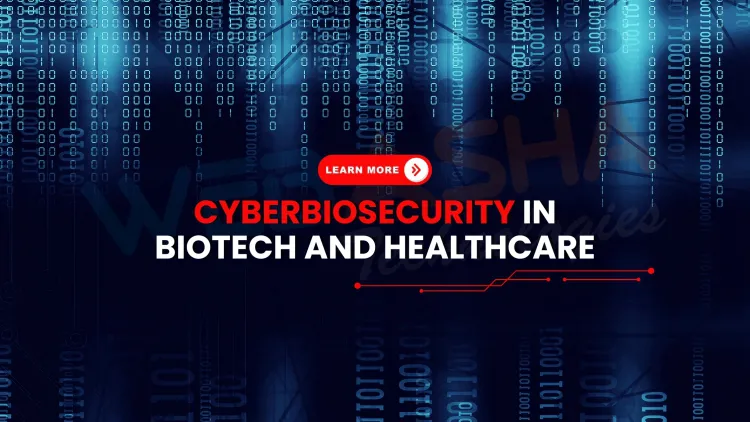What is cyberbiosecurity and how does it protect biotech and life sciences from cyber threats?
Cyberbiosecurity is an emerging field at the intersection of cybersecurity and biotechnology, focused on safeguarding genetic data, bio-automation, and life sciences IT infrastructure. As biotech labs increasingly rely on AI, IoT, and cloud platforms for genomic research and synthetic biology, cyberbiosecurity ensures data integrity, experimental control, and protection against malicious manipulation. It addresses threats from state-sponsored actors, IP theft, and smart lab compromises, making it a crucial defense layer in healthcare, pharmaceutical, and bio-research environments.

Table of Contents
- What Is Cyberbiosecurity?
- Why Is Cyberbiosecurity Important in 2025?
- How Does Biotechnology Connect to IT Infrastructure?
- Common Cyber Threats to Biotech and Life Sciences
- What Is Synthetic DNA Hacking?
- How Are Smart Labs Vulnerable?
- Who Are the Potential Attackers in Cyberbiosecurity?
- Case Study: Moderna & Vaccine IP Espionage
- How to Protect Bioinformatics and Life-Sciences IT
- Regulations and Standards in Cyberbiosecurity
- The Role of AI in Defending Biotech Systems
- The Future of Cyberbiosecurity: What to Expect?
- Conclusion
- Frequently Asked Questions (FAQs)
As biotechnology and life sciences increasingly integrate with digital infrastructure, a new cybersecurity frontier has emerged—Cyberbiosecurity. This evolving discipline focuses on protecting bio-automation systems, genetic data, and smart laboratories from cyber threats that could have real-world biological consequences.
In this blog, we explore the intersection of synthetic biology and cybersecurity, real-world threats, case studies, and how organizations can secure their life sciences infrastructure in 2025.
What Is Cyberbiosecurity?
Cyberbiosecurity is a multidisciplinary field that focuses on securing biological data, biotech devices, and bioinformatics systems from cyber threats. It merges concepts from cybersecurity, biological sciences, and information technology, ensuring that innovations in genomics and synthetic biology are not vulnerable to manipulation or theft.
Example: A cyberattack on a gene-editing system like CRISPR could lead to the creation of faulty DNA sequences, threatening health outcomes or research integrity.
Why Is Cyberbiosecurity Important in 2025?
With the rise of automated laboratories, cloud-based bioinformatics tools, and DNA storage systems, bio-labs are increasingly vulnerable to cyber intrusions. Cyberbiosecurity ensures:
-
Protection of proprietary genomic data
-
Integrity of automated experimental systems
-
Prevention of weaponization of synthetic biology
-
Safe development of personalized medicine
How Does Biotechnology Connect to IT Infrastructure?
Modern biotech companies use:
-
Cloud storage for DNA and genome databases
-
AI tools for protein folding and gene prediction
-
Robotics and automation in drug discovery
-
IoT-enabled lab equipment like smart PCR machines
All these components are connected to internal networks or the internet, making them targets for cyber threats.
Common Cyber Threats to Biotech and Life Sciences
Here are some major cybersecurity risks in biotech:
| Threat Type | Description |
|---|---|
| IP Theft | Hackers stealing genetic formulas, vaccine models, or patented organisms |
| Data Breach | Leak of patient genomic data from cloud-based bioinformatics platforms |
| System Manipulation | Altering experimental results or gene sequencing output remotely |
| IoT Exploits | Compromising smart lab equipment via firmware or wireless vulnerabilities |
| Synthetic DNA Injection | Embedding malicious code into synthetic DNA that targets gene sequencers |
What Is Synthetic DNA Hacking?
In 2017, researchers demonstrated that malicious DNA strands could be synthesized to exploit vulnerabilities in DNA sequencing software. This blurred the line between biological code and machine code, highlighting a new cyber-physical threat.
In 2025, this technique has evolved further, where cybercriminals or adversarial nation-states may use bio-malware for espionage or sabotage.
How Are Smart Labs Vulnerable?
Modern labs use:
-
Smart centrifuges
-
Connected incubators
-
Robotic liquid handlers
If compromised, attackers can:
-
Modify experiments
-
Ruin drug batches
-
Damage expensive equipment
-
Alter environmental settings (e.g., temperature or humidity)
Who Are the Potential Attackers in Cyberbiosecurity?
-
Nation-states interested in biotech espionage
-
Hacktivists protesting against genetic manipulation
-
Insiders with access to proprietary data
-
Competitors seeking trade secrets
-
Cybercriminals demanding ransom for locked research data
Case Study: Moderna & Vaccine IP Espionage
During the COVID-19 pandemic, multiple reports indicated that state-backed hackers targeted companies like Moderna and Pfizer to steal mRNA vaccine blueprints. These attacks revealed the real-world consequences of biotech cyber espionage.
How to Protect Bioinformatics and Life-Sciences IT
To mitigate risks, organizations must implement a multi-layered cyberbiosecurity strategy:
-
Zero Trust Architecture (ZTA) for biotech networks
-
End-to-end encryption of genetic data
-
Air-gapping critical lab systems
-
Multi-factor authentication (MFA) for lab access
-
AI-based anomaly detection in lab automation workflows
-
Firmware validation on all smart equipment
-
Regular penetration testing for OT (Operational Tech) in labs
Regulations and Standards in Cyberbiosecurity
While the field is still emerging, these are key guidelines:
-
NIST Cyberbiosecurity Framework (Draft)
-
FDA guidelines on connected medical and biotech devices
-
ISO 27001/27701 for data privacy in healthcare
-
CISA & DHS advisories on critical biotech infrastructure
The Role of AI in Defending Biotech Systems
AI and machine learning are being deployed to:
-
Detect abnormal bio-lab operations
-
Prevent data exfiltration from cloud bioinformatics
-
Protect against synthetic DNA injection via scanning algorithms
-
Ensure real-time threat detection across lab systems
The Future of Cyberbiosecurity: What to Expect?
Looking ahead, we anticipate:
-
Standardized cyberbiosecurity certifications
-
Global cooperation to prevent biotech espionage
-
Automated vulnerability scanning tools tailored to bio-labs
-
Increased focus on genomic privacy laws
-
Synthetic biology ethics councils to handle dual-use concerns
Conclusion
As the world moves toward AI-designed drugs, CRISPR therapies, and biotech automation, the risk of cyberattacks on life sciences cannot be ignored. Cyberbiosecurity is no longer optional—it is essential to preserve scientific integrity, public health, and national security.
Organizations in biotech, pharma, healthcare, and research must integrate robust cybersecurity practices with biosafety protocols to address the complex threats of 2025 and beyond.
FAQs
What is cyberbiosecurity?
Cyberbiosecurity is a discipline that integrates cybersecurity with biotechnology to protect genetic data, bio-automation, and lab infrastructure from cyber threats.
Why is cyberbiosecurity important?
It protects sensitive research, prevents bioterrorism, and secures automated biotech systems from cyber attacks or misuse.
How does cyberbiosecurity differ from traditional cybersecurity?
Cyberbiosecurity focuses specifically on biological data, lab equipment, and synthetic biology threats that traditional IT security may not address.
What are the biggest cyber threats to biotech companies?
Threats include IP theft, ransomware attacks, synthetic DNA injection, system manipulation, and insider sabotage.
Can synthetic DNA be hacked?
Yes. Malicious DNA sequences can be designed to exploit software vulnerabilities in gene sequencers.
What kind of data does cyberbiosecurity protect?
It safeguards genetic data, genome databases, protein structures, and automated experiment records.
How are smart labs at risk?
Smart labs use IoT-connected equipment that can be hacked to alter experiments, damage samples, or steal data.
Are there real examples of biotech cyberattacks?
Yes. Nation-state actors have targeted companies like Moderna and AstraZeneca to steal vaccine data.
What role does AI play in cyberbiosecurity?
AI helps detect anomalies in lab behavior, protect genetic data in real time, and block synthetic DNA threats.
What is synthetic DNA injection?
It is the insertion of malicious code into synthetic DNA to attack vulnerable sequencing software or hardware.
How can biotech firms protect against cyberbio threats?
By using encryption, access controls, secure lab networks, and AI-based monitoring.
What are insider threats in biotech labs?
Disgruntled or compromised staff with access to systems who may leak or sabotage research.
How is cloud computing used in life sciences?
Cloud platforms are used for genome analysis, protein modeling, and storing large biological datasets.
Are cloud bioinformatics tools safe?
Only if properly secured with encryption, MFA, and compliance with data protection regulations.
What is the impact of a breach in genetic data?
It can lead to privacy violations, misuse of health information, or unauthorized cloning and research.
Which regulations govern cyberbiosecurity?
NIST frameworks, FDA medical device security guidelines, ISO 27001/27701, and local biotech compliance laws.
What is the role of the FDA in cyberbiosecurity?
FDA provides guidance on securing connected biotech and medical devices used in clinical trials and therapies.
Can ransomware affect bio-labs?
Yes. It can lock access to experiments, genetic sequences, or halt lab automation entirely.
How does IT-OT convergence impact cyberbiosecurity?
It increases attack surfaces as lab systems (OT) get integrated with IT networks and internet services.
What is genome privacy?
It refers to the protection of an individual's genetic data from unauthorized access, misuse, or surveillance.
What is CRISPR and how is it vulnerable?
CRISPR is a gene-editing tool that could be manipulated via compromised software or connected systems.
Is AI-generated drug research at cyber risk?
Yes. If models or data pipelines are tampered with, it could result in unsafe drug formulations.
How can organizations train staff in cyberbiosecurity?
Through awareness programs, scenario-based drills, and integration of biosafety + cybersecurity policies.
Can hackers manipulate lab experiments remotely?
Yes. If lab devices are connected and unsecured, attackers could alter temperature, timing, or sequences.
Are universities targets of cyberbio attacks?
Yes. Academic institutions hold valuable research data and often have less mature security frameworks.
What is bio-malware?
It is malware coded within biological material (like DNA) or software that interacts with biological systems.
How can synthetic biology be weaponized?
By modifying organisms or pathogens maliciously—requiring strict biosecurity and cyber safeguards.
What are dual-use concerns in biotech?
Technologies meant for good (like gene editing) that could also be used for harmful purposes if misused.
Is there a global policy for cyberbiosecurity?
Not yet standardized. However, collaborations between WHO, NIST, and security agencies are increasing.
What tools are used in cyberbiosecurity?
Tools include secure LIMS (Lab Information Management Systems), biofirewalls, AI detection systems, and DNA validation software.
What’s the future of cyberbiosecurity?
Expect stronger standards, regulation, AI-based threat prevention, and integration into all biotech innovation.











![Top 10 Ethical Hackers in the World [2025]](https://www.webasha.com/blog/uploads/images/202408/image_100x75_66c2f983c207b.webp)



![[2025] Top 100+ VAPT Interview Questions and Answers](https://www.webasha.com/blog/uploads/images/image_100x75_6512b1e4b64f7.jpg)







